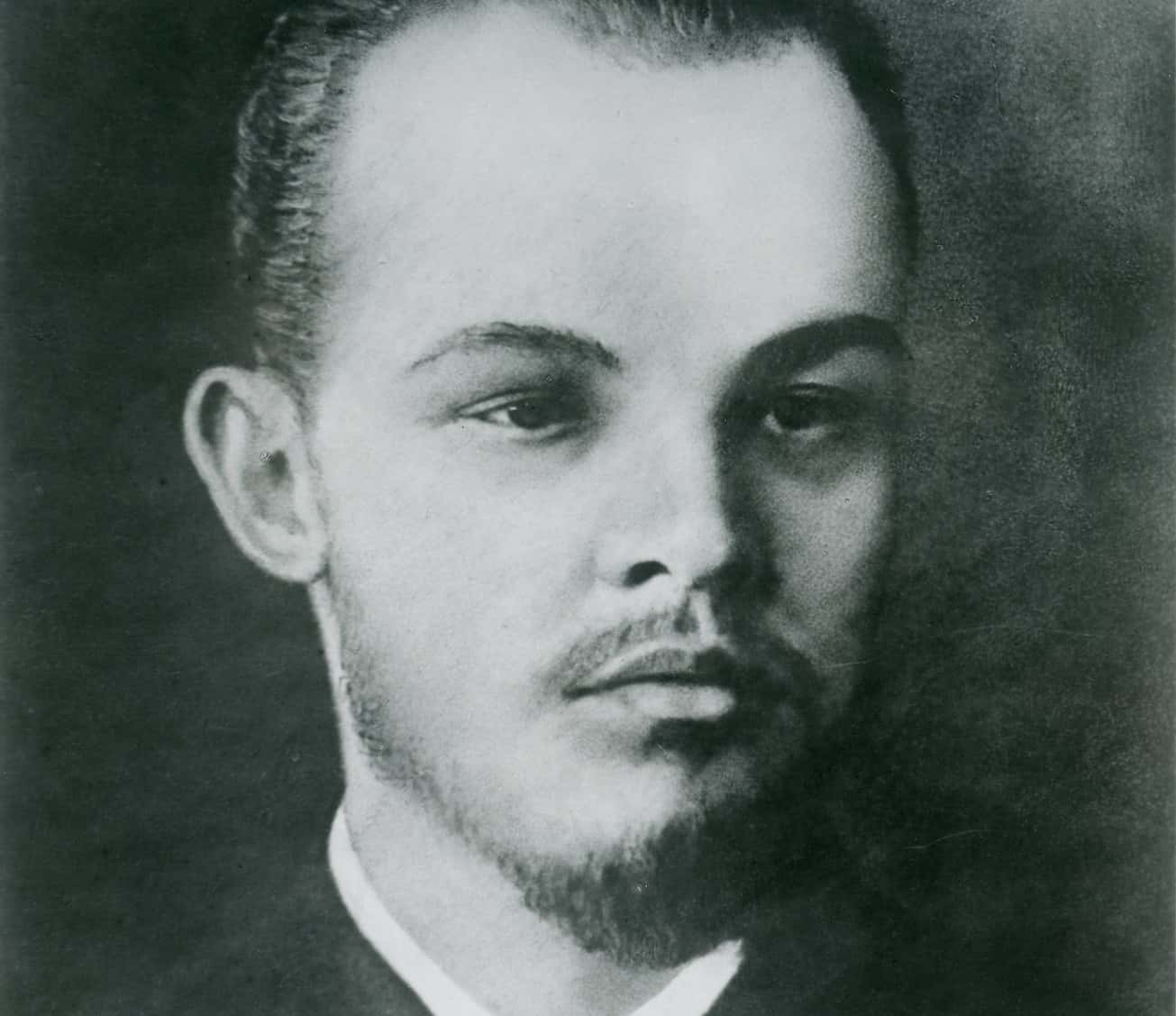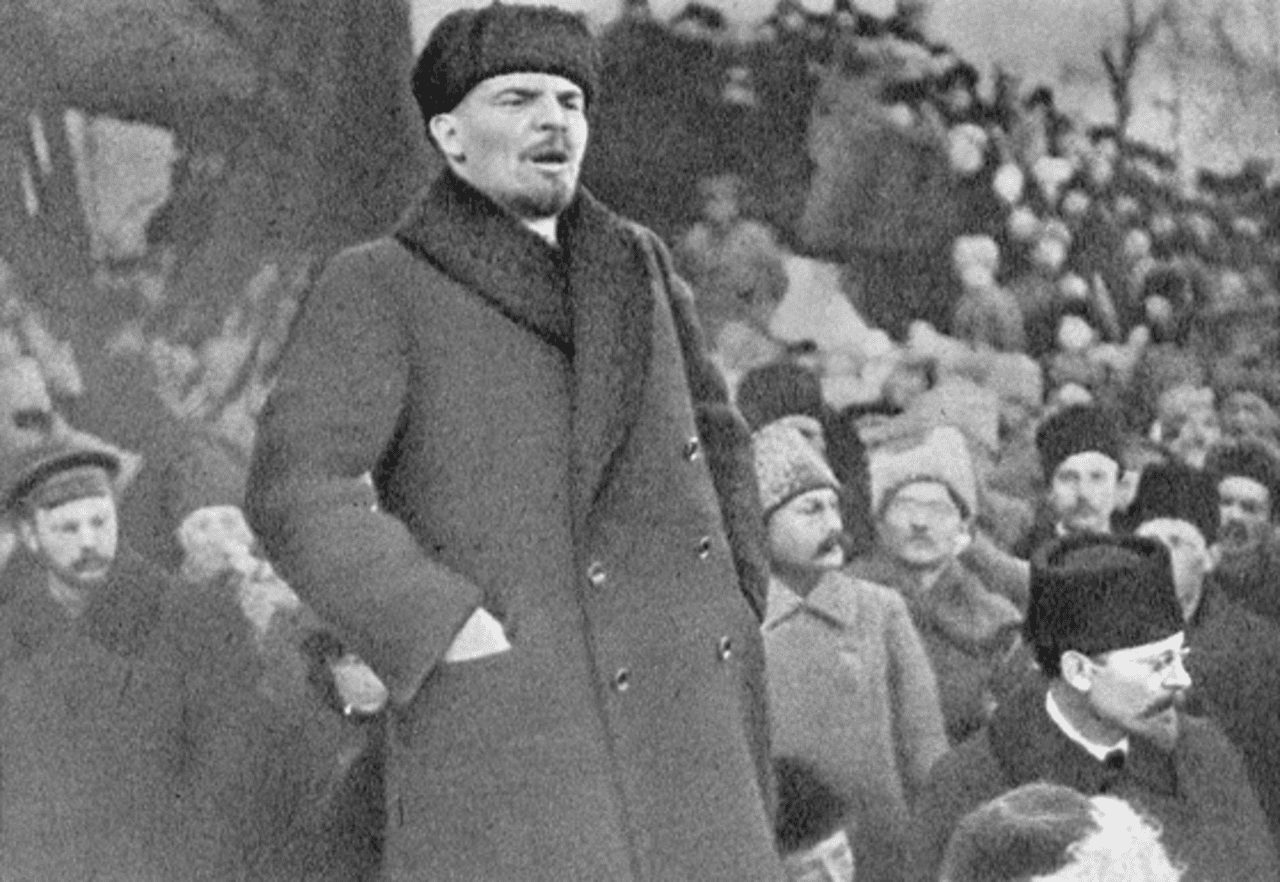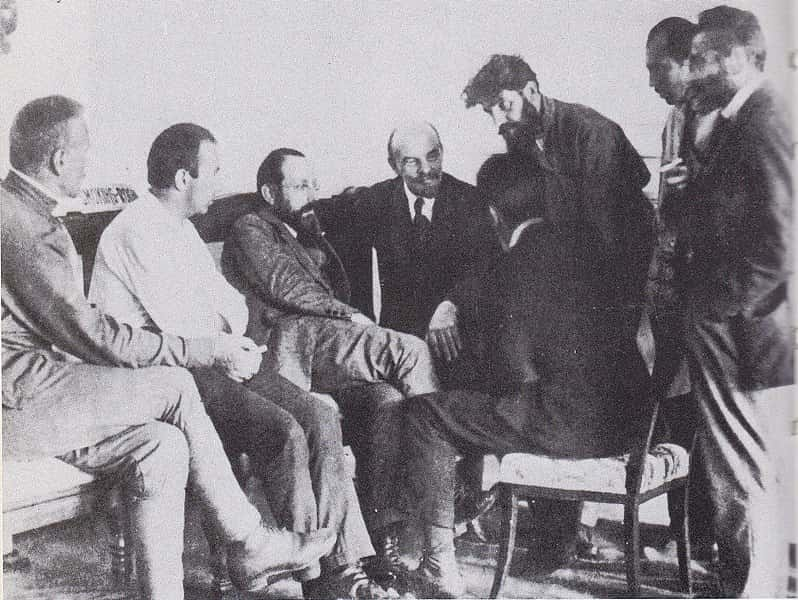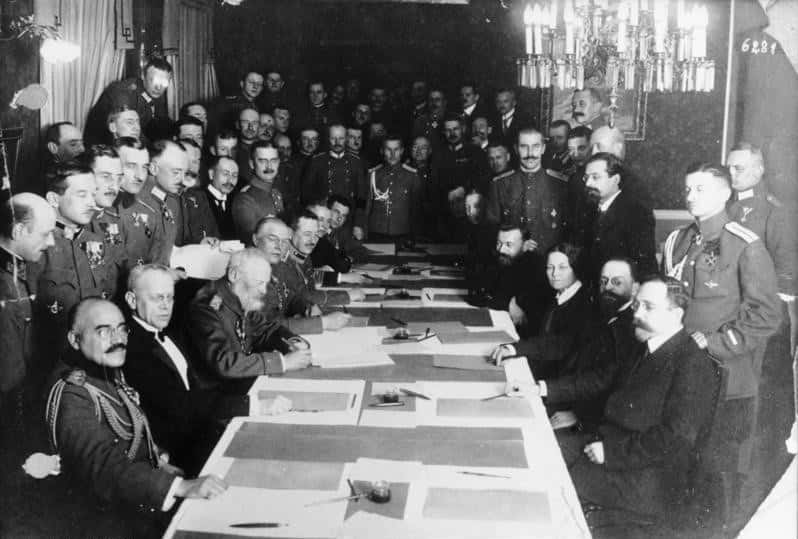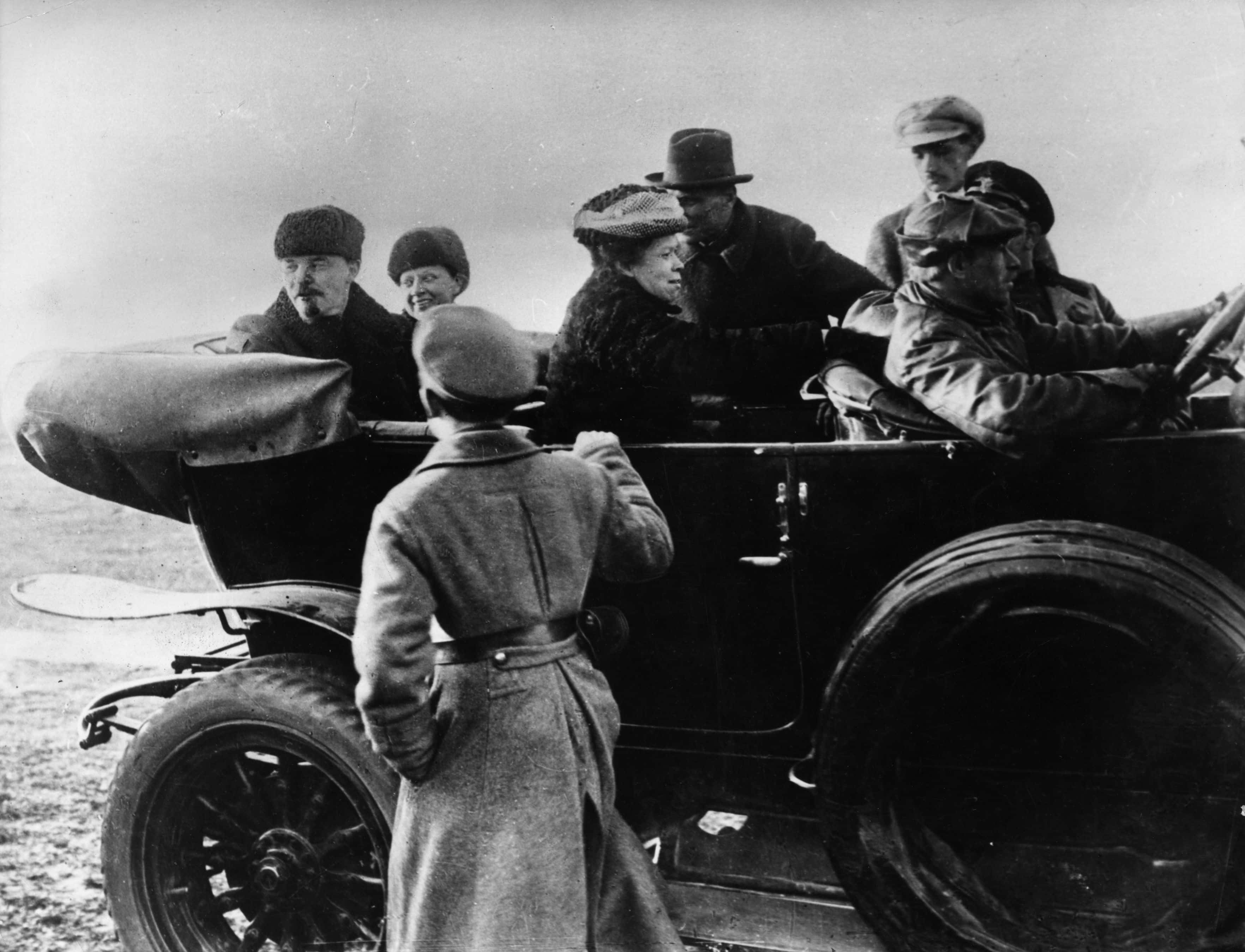Vladimir Lenin took control of Russia after centuries of rule by the Tsars. He proved to be a very controversial figure, and his successors proved no less controversial, but he left an indelible mark on Russia and the world when the revolution swept the country. From his early, tragic beginnings to his embalmed end, read on to find out more about the man behind the myth.
Vladimir Lenin Facts
44. Well, If You Have the Down Time…
In the 1890s, Lenin travelled western Europe to meet with Marxists and socialists outside of Russia. While there, he collected several publications that were illegal to own in Russia and then distributed them to the Russian people in an early display of serious activism. This action led to his getting arrested, but he was given no legal representation and detained for a year before he was even sentenced. Lenin took this year to write and work on his political theories, giving the system a metaphorical finger in its eye.
43. We Put the AA in Anti-Authoritarian!
If anyone inspired Lenin, it wasn’t his parents, but his older siblings. Lenin’s sister, Anna, and his brother, Alexander, both became embroiled in revolutionary ideas. Alexander was especially determined to end the rule of the tyrannical Tsars and belonged to a group known as the Terrorist Faction of the People’s Will, which is admittedly a name that any death metal band would be proud to have.
42. A Schism Is Born
Lenin was responsible for the creation of the word "Bolshevik." The name emerged at a meeting of the Russian Social Democratic Labor Party in 1903. Lenin and Julius Martov ended up on opposite sides of an argument. To keep it simple, Lenin claimed that a strong leader needed to have complete control over the party, while Martov said the individual members should have more leeway. Lenin dubbed his supporters "majoritarians" (since Lenin’s faction outnumbered Martov’s group in this debate), which translates to "bol’sheviki" or Bolsheviks. Martov, meanwhile, owned his position by dubbing his group the "minoritarians," or the Mensheviks.
41. Atticus Ilyfinch Lenin?
One of Lenin’s first jobs after his studies was when he worked in St. Petersburg as a lawyer. He often chose to represent poor clients who struggled against a system that was biased against them.
40. What’s in a Surname?
"Lenin" was not actually his surname, but rather a nickname he used to avoid putting his family in danger while he was working to overthrow the people in power. Lenin’s full name was Vladimir Ilyich Ulyanov.
39. A Man of the Common People, You Say?
Lenin’s background, as some might be surprised to know, was completely, even ordinarily, middle class. While his father did descend from serfs, he had done well in life, and Lenin’s mother was a well-educated woman whose father was a physician.
38. Inspiring Their Brother, Even if it Killed Them
Unfortunately, both of Lenin’s siblings came to unsuccessful ends. Anna was put under house arrest when her involvement in subversive activities were discovered. This was light punishment compared to Alexander, however. Despite the name, the group’s incompetence led to them being arrested en masse and Alexander sentenced to death. Despite appeals from Lenin’s family, Alexander was hanged, and with him died the family’s reputation amongst their peers and neighbors.
37. Now It’s Personal!
If the authorities thought that Alexander's harsh sentence would deter his little brother from following in his footsteps, they were mistaken. Lenin would spend the rest of his life defying the expectations of everyone around him. Despite enrolling in school, Lenin attracted negative attention for becoming involved in a student demonstration at Kazan University and was expelled.
36. Thanks Mom!
Like his sister, Lenin was exiled back into his mother’s home. His mother was understandably afraid for her son’s future (given what her other son’s future had become, we can’t blame her), and she urged the authorities to let him go back to Kazan (the city, not the school). Lenin did go back, but doing so introduced him to the teachings of a certain writer known as Karl Marx. His mother later tried to push him into agriculture (which failed) and even tried relocating the family (where he simply found more socialists who had fully embraced Marxism). Safe to say that her best efforts constantly backfired.

History's most fascinating stories and darkest secrets, delivered to your inbox daily.
35. I Don’t Appreciate Silence, I WANT Silence!
Lenin was apparently a complete neat-freak. He was obsessed with keeping his offices completely clean, even getting bent out of shape if the pencils weren’t sharpened. He also insisted on working in complete silence, demanding it from anyone around him. Does this mean that he was the first librarian who became a dictator?
34. Vlad, Meet Leo
During his travels in 1902, Lenin wore out his welcome in Germany with his promotion of Marxism, so he fled to London, just a step ahead of the police. It was in London that he met fellow Marxist-in-exile, Leon Trotsky. The two men became friends immediately and formed what would be a partnership that changed both their lives forever.
33. A Mid-Life Crisis
In 1916, Lenin was still abroad when he received word that his mother had died. Stricken by this loss, things got worse when Lenin was unable to attend her funeral. In the midst of his depression around that time, Lenin also expressed fear that he wouldn’t live long enough to see the revolution of the proletariat against the bourgeoisie and the aristocracy.
32. Just a Boy Meeting a Girl
Lenin was attending discussion groups on Marxism when he met his future wife, Nadezhda Krupskaya. She had been born into an upper-class family that had become impoverished, yet she had been well-educated and was a deep admirer of Karl Marx. Neither Lenin or Krupskaya ever really wrote about their relationship, and it may have been more professional than affectionate.
31. Now That’s Amore!
In October 1896, Nadezhda Krupskaya was arrested just a few months after Lenin. After some time, Lenin was sentenced to live in Siberia as an exile. With some help in passing on the word, Lenin suggested to Krupskaya that if she told the authorities that she was his fiancée, she could go into exile with him. Krupskaya immediately did so and was allowed to be with Lenin in exile on the condition that they marry as soon as they were reunited. You’d hardly have to tell them twice!
30. You’re Made for Good Things, I Can Tell
In 1913, Lenin was staying in Poland with his wife when he was visited by a young revolutionary. They reportedly spent his visit discussing the role of non-Russian ethnic groups in the Russian Empire. Lenin described his visitor as the “wonderful Georgian” (the region, not the US state). As it turns out, this splendid fellow, who would end up playing a huge role in Lenin’s future, would later be known to the world as Joseph Stalin. Unfortunately, Lenin's feelings about Stalin would sour.
29. They Hate Me More Than They Hate You!
When World War I broke out in 1914, Lenin was in exile in the Galicia, which was part of the Austro-Hungarian Empire, which was allied with Germany against Russia. The Austro-Hungarians arrested Lenin on suspicion that this Russian expatriate might be trouble for them. But Lenin was quick to display his utter hatred for the Tsar, and he was released.
28. The Time Has Come!
In 1917, industrial workers went on strike over terrible working conditions and lack of food. The movement became so widespread that the Tsar abdicated and a provisional government was established to convert Russia into a Republic. The news caused Lenin and his friends to celebrate and embark on a journey back to Russia.
27. A Win-Win Situation
Unfortunately for Lenin, getting back to Russia to join in the Revolution proved harder than he imagined: The roads to Russia were closed off, especially because WWI was still raging. However, the German government realized that Lenin taking charge of Russia would be beneficial for them, since the far left had always deeply opposed the war and were prepared to stop fighting. Therefore, they allowed a train car containing Lenin, his wife, and over 30 associates to pass through Germany on the way to Russia.
26. Lived Long Enough to See Yourself Become the Villain
By 1918, Lenin and the Bolsheviks had expelled the other parties from the new Soviet government, including the Mensheviks and the Socialist Revolutionaries (SR). One member of the SR, Fanny Kaplan, was inspired to use bullets to show her disagreement with Lenin. On the 30th of August 1918, Kaplan approached Lenin and fired three shots. One of the bullets only hit his coat, while the others hit his shoulder and neck, with the latter making it down to his lung. Amazingly, he survived these injuries, while Kaplan’s assassination attempt made his government reintroduce the death penalty just so she could be executed.
25. Am I Doing Something Wrong?
Not only was Fanny Kaplan not the first person to try to assassinate Lenin, she also wasn’t the first person to try to assassinate him that very same year! Lenin had previously been shot at in January of 1918.
24. Prepare for Terror
Following the double attempts on Lenin’s life, the Bolsheviks began what is known now as "the Red Terror." It’s said that as many as 15,000 people viewed as enemies to Lenin’s government were killed within two months of Fanny Kaplan’s attack on Lenin.
23. I Renounce a God Who’d Make Me Fatherless
When Lenin was 16 years old, his father died of a brain hemorrhage. This tragedy left a serious impact on Lenin, and he became aggressive in his mood. He also embraced atheism for the first time in his life. And this was all before his brother was hanged for plotting to kill the Tsar.
22. Home on the Range, Indeed!
At one point during his mother’s attempts to dissuade Lenin from a life leading to revolution and violence, she bought farmland. Her hope was that Lenin would turn to agriculture instead of Marxism. Lenin ultimately did study farming, but what he took note of was the extreme poverty faced by the Russian farmers, which only fueled his political views. But despite his sympathy for his neighbors, Lenin’s livestock and farming equipment were constantly being stolen by the suspicious locals. Lenin’s mother finally had enough and sold the farmland, while Lenin continued to ignore her wish that he’d get out of his rebellious phase.
21. Stop Stallin’! Depose Stalin!
After Lenin’s death, a power vacuum was created, which was eventually filled by Joseph Stalin. Stalin painted a picture of himself as having been a great friend of Lenin’s to gain the people’s trust. This flew in the face of Lenin’s testament, which he gave to his wife for safekeeping. In the document, Lenin expressed his disgust with Stalin’s rudeness and his uncouthness. Lenin even urged his allies, such as Leon Trotsky, to depose Stalin before he got too powerful. Unfortunately, the testament was suppressed by those allies, the advice went unheeded, and Stalin came to power. On the bright side, Lenin’s own bloody reputation looks much better next to the horror unleashed by Stalin.
20. An Interesting, But Flawed, Loophole
Allegedly, criminals began tattooing their bodies with Lenin and Stalin’s faces because they felt it would deter authorities (who, it's said, wouldn't want to deface their leaders' images) from shooting at them.
19. There Is No God!
Lenin pushed for a complete embrace of atheism when it came to the new Soviet Government. He declared a permanent separation of church and state, forbade religious teaching in school, and also wrote snide comments on the 1920s version of Reddit, I assume.
18. Power to the People… Wait, Not All of It
When Lenin first came to the height of his power, his government also declared a censoring of any press outlets that were deemed "counter-revolutionary." This prompted an outcry, even from many Bolsheviks, that it was against Free Speech and also against the policies of the Left. Assurances that the measure was temporary were proved wrong when, well, the decree was never lifted.
17. The Most Dedicated Principal Ever
One thing that Lenin knew the value of was education. When he took power in the newly formed Soviet Union, he ensured that education for children would be free of charge across the nation. He also began a literacy campaign to combat the overwhelming lack of reading skills amongst the Russians. From 1920 to 1926, five million people underwent this crash course.
16. What’s So Civil About War Anyway?
From 1918 to 1920, enemies of the Bolsheviks, backed by the western powers, attempted to oust control from Lenin and the Bolsheviks. The Russian Civil War became a conflict between the Red Faction (the Bolsheviks) and the White Faction (almost everyone else). As you can imagine, the White Faction was fragmented, featuring several units who acted independently of each other. The Red Faction, meanwhile, was far more centralized and focused. Despite support from the British, French, Americans, Italians, and Serbians, it was Lenin who prevailed. Unfortunately, the war took a devastating toll.
15. Guys, Can We Cool It on the Anti-Semitism?
As history had seen many times, and would see again in the future, Jewish communities were heavily persecuted during the Russian Civil War. Both the White and the Red factions were guilty of these attacks. However, Lenin rose above it to publicly condemn anti-Semitism in all its forms, saying that it was the fault of capitalist propaganda that anti-Semitism was so prevalent.
14. War on God
Despite his official stance against persecuting Jews, Lenin paradoxically also persecuted organizations that opposed his government’s views on religion and its role in society. In 1922, Lenin decreed that anti-Bolshevik Christian priests be executed, which led to at least 14,000 people dying. While all religious organizations were targeted in some capacity, the Russian Orthodox Church received the brunt of Lenin’s wrath.
13. A Modest Dictator
For a man who would wield such power in his lifetime, Lenin surprisingly preferred the spartan lifestyle. Lenin stayed away from luxury, living simply even when he was in charge of the Soviet Union. According to biographer Louis Fischer, Lenin also had serious issues with the cult built around himself within the Soviet Union, which is probably one reason why it only took off after his death.
12. The Former Exile Sending Thousands Into Exile
Another thing that Lenin began was the establishment of the Russian gulag system. By 1920, 84 camps held tens of thousands of prisoners engaged in slave labor. In 1923, the number of camps grew to 315, holding over 70,000 enemies of the Bolsheviks. The gulag system gained even more prominence under Joseph Stalin (and a much bigger body count), but it was a system that began with Lenin.
11. Well This Is Awkward…
One of the most devastating events of Lenin’s time as head of the Soviet Union was the Russian famine of 1921. Drought had affected the harvests that year, and the government had exported a large amount of grain. Five million Russians are said to have died during this time. Things were so bad that the United States tasked a relief administration with sending much-needed food.
10. Over My Cold, Dead Body!
When Lenin died, his body was sent to Moscow by train. Over a million people journeyed to the rail line to pay their respects as Lenin’s body went past, despite the January weather (in Russia, to boot).
 Wikimedia Commons
Wikimedia Commons
9. Who Are You Calling Sauerkraut!?
Because of the safe passage he received from the Germans to get back to Russia, and because he was adamantly opposed to continuing the war, Lenin was decried by his enemies as a German agent.
8. No Take-Backsies!
Lenin almsot immediately declared peace with Germany when he gained power. The subsequent Treaty of Brest-Litovsk was a disastrous agreement on the Russian side, while the Germans benefitted greatly from the treaty, winning large tracts of land and gaining the ability to focus all their energy on the western front. However, Lenin got the last laugh when he later repudiated the treaty.
7. Vengeance Be Mine
Lenin never forgot the cold execution of his brother, and many years later, he finally got the chance to take an even colder revenge against the royal family. The Tsar, his wife, their children, and their most loyal servants were taken into a basement. In a chaotic execution, they were shot or stabbed. Alexander had wanted to end the Tsars once and for all, and so Lenin granted his brother’s wish.
6. Woke Bae?
Surprisingly, Lenin was what some might call a feminist, in that he staunchly believed in the equality of men and women and acted to give women more freedom to divorce their husbands and be financially independent. During his time, the Zhenotdel was established by two feminist revolutionaries. This was an organization devoted to women’s affairs, pushing for higher education among women and making them aware of their rights in this new Communist nation.
5. Working Woman
As proof that he held women to an equal standard, Lenin’s wife, Nadezhda Krupskaya, wasn’t just a trophy on his arm. According to Leon Trotsky, Krupskaya was at the very center of all the goings on within the Russian Social Democratic Labor Party. She continued playing an active role during the time of the Soviet Government, being the person behind the new Russian education system. Krupskaya was the Deputy Minister of Education for ten years until her death in 1939.
4. Won by Blood
Lenin’s taste for violence to enforce his rule stemmed from brutal lessons he learned while he was involved in defying the Tsars. In January 1905, over 100,000 unarmed demonstrators marched to the Winter Palace to petition the Tsar. Their lack of weapons didn’t stop the powers that be from sending over 10,000 soldiers to open fire on the crowd. As a result, Lenin was convinced that extreme force was the only thing that would work, and it was a philosophy he never forgot.
3. My Goodness, the Poor Children
In a strange contrast to the horrifying effects of the Red Terror, Lenin set up a state system of orphanages around the Soviet Union to ensure that children who lost their parents had somebody to care for them. Granted, some of those children may have lost parents to the Red Terror, so this might have to be counted as a mixed blessing.
2. If I Was a Dictator…
Interestingly, Lenin’s mother was actually of Jewish background. It’s debatable whether Lenin himself ever knew about this, as this kind of information would have been hidden in the very anti-Semitic Russia. One person who did find out was Lenin’s sister, Anna. After Lenin’s death, Anna petitioned Joseph Stalin to reveal the news of her family’s Jewish background, as she felt that it would do a lot to combat the anti-Semitism in Russia. Instead, Stalin suppressed the information, determined that it never be found out.
1. Give the People What They Want
If you’ve ever wanted to see Lenin for yourself, you’re more than able to do so. His body was embalmed and put on display, initially because of a decision to display his body for the traditional mourning period of 40 days. However, they kept it going after the body proved more popular to visit than they’d anticipated. As of 2018, Lenin’s corpse is still preserved and still on display at Red Square in Moscow. Feel free to go visit.









